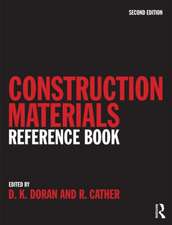Handbook of Low Carbon Concrete
Autor Ali Nazari, Jay G. Sanjayanen Limba Engleză Paperback – 3 oct 2016
In addition, the book provides expert coverage on emissions due to concrete batching, transport and placement, and emissions generated by typical commercially produced concretes.
- Includes the tools and methods for reducing the emissions of greenhouse gases
- Explores technologies, such as carbon capture, storage, and substitute cements
- Provides essential data that helps determine the unique factors involved in designing large, new green cement plants
Preț: 622.32 lei
Preț vechi: 683.88 lei
-9% Nou
Puncte Express: 933
Preț estimativ în valută:
119.08€ • 124.34$ • 98.33£
119.08€ • 124.34$ • 98.33£
Carte tipărită la comandă
Livrare economică 08-22 aprilie
Preluare comenzi: 021 569.72.76
Specificații
ISBN-13: 9780128045244
ISBN-10: 0128045248
Pagini: 442
Dimensiuni: 152 x 229 x 25 mm
Greutate: 0.65 kg
Editura: ELSEVIER SCIENCE
ISBN-10: 0128045248
Pagini: 442
Dimensiuni: 152 x 229 x 25 mm
Greutate: 0.65 kg
Editura: ELSEVIER SCIENCE
Public țintă
Civil Engineers, Researchers, Designers, Material Engineers, and Environmental EngineersCuprins
1. Greenhouse Gas Emissions Due to Concrete Manufacture
2. Life Cycle CO 2 Evaluation on Reinforced Concrete Structures With High-Strength Concrete
3. Assessment of CO 2 Emissions Reduction in High-Rise Concrete Office Buildings Using Different Material-Use Options
4. Eco-Friendly Concretes With Reduced Water and Cement Content: Mix Design Principles and Experimental Tests
5. Effect of Supplementary Cementitious Materials on Reduction of CO 2 Emissions From Concrete
6. Binder and Carbon Dioxide Intensity Indexes as a Useful Tool to Estimate the Ecological Influence of Type and Maximum Aggregate Size on Some High-Strength Concrete Properties
7. CO 2 Reduction Assessment of Alkali-Activated Concrete Based on Korean Life-Cycle Inventory Database
8. Introducing Bayer Liquor–Derived Geopolymers
9. Alkali-Activated Cement-Based Binders (AACBs) as Durable and Cost-Competitive Low-CO 2 Binder Materials: Some Shortcomings That Need to be Addressed
10. Progress in the Adoption of Geopolymer Cement
11. An Overview on the Influence of Various Factors on the Properties of Geopolymer Concrete Derived From Industrial Byproducts
12. Performance on an Alkali-Activated Cement-Based Binder (AACB) for Coating of an OPC Infrastructure Exposed to Chemical Attack: A Case Study
13. Alkali-Activated Cement (AAC) From Fly Ash and High-Magnesium Nickel Slag
14. Bond Between Steel Reinforcement and Geopolymer Concrete
15. Boroaluminosilicate Geopolymers: Current Development and Future Potentials
2. Life Cycle CO 2 Evaluation on Reinforced Concrete Structures With High-Strength Concrete
3. Assessment of CO 2 Emissions Reduction in High-Rise Concrete Office Buildings Using Different Material-Use Options
4. Eco-Friendly Concretes With Reduced Water and Cement Content: Mix Design Principles and Experimental Tests
5. Effect of Supplementary Cementitious Materials on Reduction of CO 2 Emissions From Concrete
6. Binder and Carbon Dioxide Intensity Indexes as a Useful Tool to Estimate the Ecological Influence of Type and Maximum Aggregate Size on Some High-Strength Concrete Properties
7. CO 2 Reduction Assessment of Alkali-Activated Concrete Based on Korean Life-Cycle Inventory Database
8. Introducing Bayer Liquor–Derived Geopolymers
9. Alkali-Activated Cement-Based Binders (AACBs) as Durable and Cost-Competitive Low-CO 2 Binder Materials: Some Shortcomings That Need to be Addressed
10. Progress in the Adoption of Geopolymer Cement
11. An Overview on the Influence of Various Factors on the Properties of Geopolymer Concrete Derived From Industrial Byproducts
12. Performance on an Alkali-Activated Cement-Based Binder (AACB) for Coating of an OPC Infrastructure Exposed to Chemical Attack: A Case Study
13. Alkali-Activated Cement (AAC) From Fly Ash and High-Magnesium Nickel Slag
14. Bond Between Steel Reinforcement and Geopolymer Concrete
15. Boroaluminosilicate Geopolymers: Current Development and Future Potentials




















